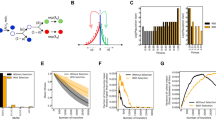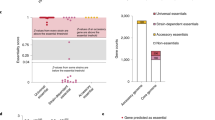Abstract
Although modern DNA sequencing enables rapid identification of genetic variation, characterizing the phenotypic consequences of individual mutations remains a labor-intensive task. Here we describe array-based discovery of adaptive mutations (ADAM), a technology that searches an entire bacterial genome for mutations that contribute to selectable phenotypic variation between an evolved strain and its parent. We found that ADAM identified adaptive mutations in laboratory-evolved Escherichia coli strains with high sensitivity and specificity.
This is a preview of subscription content, access via your institution
Access options
Subscribe to this journal
Receive 12 print issues and online access
$259.00 per year
only $21.58 per issue
Buy this article
- Purchase on Springer Link
- Instant access to full article PDF
Prices may be subject to local taxes which are calculated during checkout



Similar content being viewed by others
References
Herring, C.D. et al. Nat. Genet. 38, 1406–1412 (2006).
Shendure, J. & Ji, H. Nat. Biotechnol. 26, 1135–1145 (2008).
Albert, T.J. et al. Nat. Methods 2, 951–953 (2005).
Silhavy, T.J., Berman, M.L. & Enquist, L.W. Experiments with Gene Fusions (Cold Spring Harbor Press, Plainview, NY, 1984).
Girgis, H.S., Liu, Y., Ryu, W.S. & Tavazoie, S. PLoS Genet. 3, 1644–1660 (2007).
Badarinarayana, V. et al. Nat. Biotechnol. 19, 1060–1065 (2001).
Giaever, G. et al. Nature 418, 387–391 (2002).
Jacobs, M.A. et al. Proc. Natl. Acad. Sci. USA 100, 14339–14344 (2003).
Lenski, R.E., Winkworth, C.L. & Riley, M.A. J. Mol. Evol. 56, 498–508 (2003).
Sniegowski, P.D., Gerrish, P.J. & Lenski, R.E. Nature 387, 703–705 (1997).
Elena, S.F. & Lenski, R.E. Nat. Rev. Genet. 4, 457–469 (2003).
Metzgar, D. & Wills, C. Microbes Infect. 2, 1513–1522 (2000).
Blattner, F.R. et al. Science 277, 1453–1474 (1997).
Ausubel, F.M. et al. Current Protocols in Molecular Biology (Wiley Interscience, New York, 1994).
Neidhardt, F.C., Bloch, P.L. & Smith, D.F. J. Bacteriol. 119, 736–747 (1974).
Amini, S., Goodarzi, H. & Tavazoie, S. PLoS Pathog. 5, e1000432 (2009).
Baba, T. et al. Mol. Syst. Biol. 2, 2006 0008 (2006).
Datsenko, K.A. & Wanner, B.L. Proc. Natl. Acad. Sci. USA 97, 6640–6645 (2000).
Cover, T. & Thomas, J. Elements of Information Theory 2nd edn. (Wiley-Interscience, Hoboken, New Jersey, USA 2006).
Elemento, O., Slonim, N. & Tavazoie, S. Mol. Cell 28, 337–350 (2007).
Acknowledgements
We thank J. Liu for assistance in creating the ASN* strain. A.K.H. was supported by fellowship #08-1090-CCR-EO from the New Jersey Commission on Cancer Research. S.T. was supported by grants from the National Science Foundation Career Award (CAREER), Defense Advanced Research Projects Agency, National Institute of General Medical Sciences (P50 GM071508) and the National Institutes of Health Director's Pioneer Award (1DP10D003787-01).
Author information
Authors and Affiliations
Contributions
H.G. conceived and designed the approach, performed experiments, analyzed the data and wrote the paper; A.K.H. performed experiments, analyzed the data and wrote the paper; S.T. wrote the paper.
Corresponding author
Supplementary information
Supplementary Text and Figures
Supplementary Figures 1–6, Supplementary Tables 1–5 and Supplementary Note 1 (PDF 1763 kb)
Supplementary Software 1
ADAM computational tools (ZIP 3911 kb)
Rights and permissions
About this article
Cite this article
Goodarzi, H., Hottes, A. & Tavazoie, S. Global discovery of adaptive mutations. Nat Methods 6, 581–583 (2009). https://doi.org/10.1038/nmeth.1352
Received:
Accepted:
Published:
Issue Date:
DOI: https://doi.org/10.1038/nmeth.1352
This article is cited by
-
Comprehensive molecular characterization of Methylobacterium extorquens AM1 adapted for 1-butanol tolerance
Biotechnology for Biofuels (2016)
-
Transposon sequencing: methods and expanding applications
Applied Microbiology and Biotechnology (2016)
-
Quantitative analysis of intracellular communication and signaling errors in signaling networks
BMC Systems Biology (2014)
-
Evolution of Escherichia coli rifampicin resistance in an antibiotic-free environment during thermal stress
BMC Evolutionary Biology (2013)
-
Microbial laboratory evolution in the era of genome‐scale science
Molecular Systems Biology (2011)



